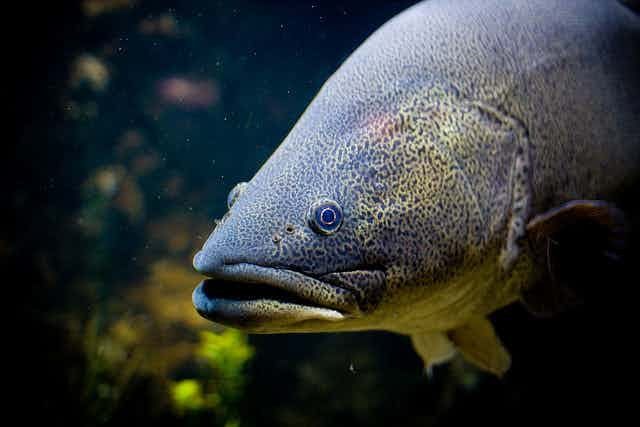The Murray cod (Maccullochella peelii) is the largest native Australian freshwater fish species, and is probably the most iconic.
The species’ credentials are impressive: it can live for more than 50 years and has been recorded weighing over 100kg and measuring longer than 1.5m. It can move hundreds of kilometres. It was and is important culturally and as food for Indigenous Australians. Once it formed the basis of an important commercial inland fishery, and it remains one of the most popular recreational fisheries in this country.
The Murray cod is also one of our most beautiful freshwater fishes, with a creamy-white underside, and a green mottling on its body and broad head.
Its natural distribution is within the Murray-Darling Basin, and it can be found, at least historically, from clear upland streams to turbid lowland rivers, but likes cover, especially submerged logs (or “snags”).
The Murray cod matures at about four or five years and breeds predictably between September and December in the main channel of rivers, usually when water temperatures are above 15°C. Breeding isn’t associated with rises in flow as once thought.
Murray cod may spawn more than once per season. Between 10,000 and 90,000 eggs are laid either in hollows in the river bank or on snags either in hollows in the river bank or on or in snags. The male remains to guard the eggs, and he continues to watch the newly hatched larvae until they are about a week old. The young fish then emerge into the river and drift downstream for several days.
Status
Murray cod are listed as critically endangered by the IUCN, and as vulnerable under the Environmental Protection of Biodiversity and Conservation Act, and by the Australian Society for Fish Biology.
The IUCN listing states that numbers of Murray cod have substantially fallen. There is considerable controversy over the status of Murray cod because many recreational fishers consider the species abundant and widespread, not least because it is stocked widely by commercial organisations, fishing clubs and government agencies. Changing ideas of what the “natural” size and age structure is may be contributing to these perceptions.
Threats
Murray cod suffered severely from commercial overfishing from the mid 1800s, and the few records indicate massive declines through the late 1800s and into the 1950s. Commercial fishing has now mostly ceased.
Now Murray cod are threatened by a variety of factors.
Recreational overfishing is still a problem. Many anglers catch and release fish but there is still intense pressure in particular locations. The closed season (1 September-1 December) needs attention considering that fish breed into December in some parts of the rivers.
Habitat, breeding and feeding are affected by the removal of dead trees (desnagging) and loss of riverside vegetation.
Water regulation means there is higher flow during the breeding season, which is a major challenge for Murray cod larvae. Potentially millions of young fish are physically pumped out of the river onto farms during the breeding season.
There are now barriers to fish movement on the river such as weirs and dams, which severely impact on adult fish migrating up and down, and larval fish dispersing downwards.
Dams pose a another threat when water is released into the river. Blackwater events can cause low oxygen levels, causing fish deaths, while cold water impacts on fish larvae and eggs, which do not survive below 13°C.
Invasive species, particularly Redfin (Perca fluviatalis), likely eat the young stages of Murray cod. Intensive aquaculture and introduced species also have the potential to introduce viruses and disease into wild fish.
Widespread stocking may mask the true status of the species, leading to reduced urgency of conservation actions.
Strategy
A recovery plan for Murray cod was prepared in 2010. Its main aim is to have self-sustaining populations throughout the river system. The target is to restore the species to 60% of pre-European numbers in 50 years.
As part of the recovery, a number of actions have been proposed. Gaps in the knowledge of Murray cod biology need to be filled to ensure sustainable management. Distribution and population structure need to determined, as well as the habitat use by different life stages. River flow can then be managed to encourage breeding and survival. Risk of threats, and benefits of recovery actions need to be assessed.
Murray cod is fished recreationally throughout its range and is targeted by almost half of all Victorian fishers. More than one million are stocked each year in the Murray-Darling Basin, and nine million were stocked in NSW and Victoria from 2000-2010. Concerns about the number of fish being removed before reaching maturity has led to the recent minimum legal length being raised from 500 to 600 mm in NSW, Victoria and the ACT.
Conclusion
It is indeed an interesting situation where a species listed variously as critically endangered, threatened or vulnerable forms the basis of such a popular and economically important recreational fishery. But with proper fisheries management, community engagement and conservation, the future may be brighter for Murray cod than it has been for many decades.
The Conversation is running a series on Australian endangered species. See it here

